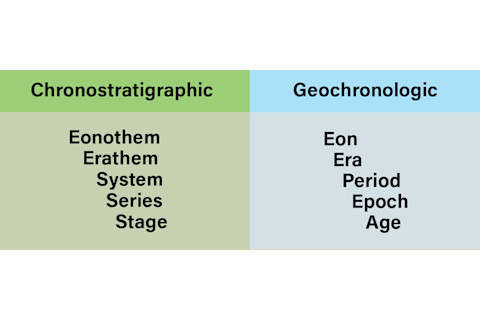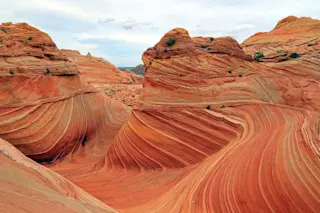Chronostra-what? The long word may be new to you, but you’ll find the concept familiar. Case in point: Jurassic Park. You can thank chronostratigraphy for the name, even though any dino nerd will tell you it should have been called Cretaceous Park. That’s because most of the animals in the park, including T. rex, lived around the end of the Cretaceous, tens of millions of years after the Jurassic. How do paleontologists know that? Thank chronostratigraphy for that one, too.
During 18th-century mining explorations and early 19th-century fossil digs, expeditioners noticed similarities in rocks over large geographic areas. And so stratigraphy — the study of layers (strata) of rock in relation to each other — was born. Chronostratigraphy is a modern offshoot of this discipline, organizing these dateable rock layers into chronological units. The standardized system gives geologists, paleontologists, and researchers from many other fields a framework of how our planet, and life on it, has changed over time.

Geologic units of time not to scale; not all units shown. For the complete International Chronostratigraphic Chart, visit stratigraphy.org. (Credit: Dan Bishop/Discover)
Dan Bishop/Discover
Units Big and Small
Eonothems/Eons: The entirety of Earth’s existence is formally divided into just three of these largest of units. Two of them — the Archean and Proterozoic — are informally lumped together as Precambrian Time. A third span, the Hadean, is also included in the Precambrian; it represents our planet’s infancy, starting some 4.6 billion years ago. But due to the dearth of dateable geologic material from that far back in time, scientists disagree on whether the Hadean should be recognized as a formal eon. However you divvy up Precambrian Time, it ended a mere 541 million years ago. The eon that followed, the Phanerozoic, is still going strong today.
Erathems/Eras: These units broadly reflect evolving complexity among living things. The Phanerozoic, for example, is divided into three erathems, or eras: Paleozoic (“old life,” from rapidly diversifying multicellular organisms to the first land vertebrates), Mesozoic (“middle life,” including dinosaurs, early mammals and the first flowering plants) and Cenozoic (“recent life,” basically everything that survived or evolved after the mass extinction that ended the Mesozoic 66 million years ago).
Systems/Periods: Generally 30 million to 80 million years long, though the current Quaternary began just 2.58 million years ago.
Series/Epochs: About 13 million to 35 million years long.
Stages/Ages: The smallest of the units, they last 2 million to 10 million years. Paleontologists and other researchers using chronostratigraphy, or its twin, geochronology, typically report results based on stage (or age) rather than a larger unit.
A Rocky Start
In the 19th century, early geologists went on a naming spree, labeling rock formations including strata. With similar enthusiasm, they started arguing about them. Several early attempts at standardizing the names failed. It wasn’t until the 1960s that the International Union of Geological Sciences created a system and nomenclature that everyone could, more or less, agree on.
The current system organizes geologic time into five kinds of units, nested like Russian dolls. Think of it as the deep time version of a month being broken down into seconds, minutes, hours, days and weeks. Despite this orderly hierarchy, some confusion remains for the non-scientist. Because the system evolved from using both relative and absolute dating methods, there are two coexisting names for each type of unit. You may see, for example, the Cretaceous called either a system (the chronostratigraphic unit, emphasizing the position of rock strata relative to each other) or a period (the geochronologic unit, emphasizing the actual, or absolute, age of the rock). Either way, the Cretaceous began 145 million years ago and ended, along with all dinosaurs except birds, 66 million years ago.

(Credit: Gemma Tarlach)
Gemma Tarlach
Divide and Conquer?
Boundaries between units are determined by events such as changes in the fossil record, polarity reversals in Earth’s magnetic field, significant climate shifts or large global deposits of a particular mineral or type of rock. The Carboniferous of 300 million to 360 million years ago, for example, got its name from massive coal deposits that formed during its span across much of the world.
What’s in a Name?
Chronostratigraphy and closely related disciplines have been evolving for more than 200 years, so perhaps it’s no surprise that the names of units are a mishmash of the scientific and the sentimental, the practical and the poetic.
Geographic: Many units are named for the geographic location where rocks and fossils of that age were first recorded, such as the Permian (Perm, a Russian city about 700 miles east of Moscow) and the Jurassic (after the Jura Mountains of France and Switzerland).
Historical: In the mid-19th century, European geologists often borrowed the names of ancient peoples, such as the Silurian and Ordovician, after two ancient tribes of Wales. Or they’d take inspiration from ancient towns, such as the Zanclean, honoring the pre-Roman name of what’s now the Italian city of Messina.
Sequential: Some periods (or systems) of the Paleozoic, including the Devonian, are simply divided into upper, middle and lower epochs (or series).
Geological: Similar to the Carboniferous, the Cretaceous is named for global deposits of creta (Latin for “chalk”). The origins of the Triassic’s name reflect a distinctive trilayer of rocks first found in northern Europe.
Environmental: The Cryogenian, about 635 million to 720 million years ago, reflects the “snowball” state of Earth during prolonged ice ages.
Alternate: While the International Commission on Stratigraphy recognizes one global name for each unit, a number of regional differences persist, usually for recent ages, which have yielded the most detailed data. For example, within the Quaternary, our current period, the age before the Holocene is known as the Devensian in the United Kingdom, the Weichselian in much of northwestern Europe, and the Wisconsinan in the U.S.















